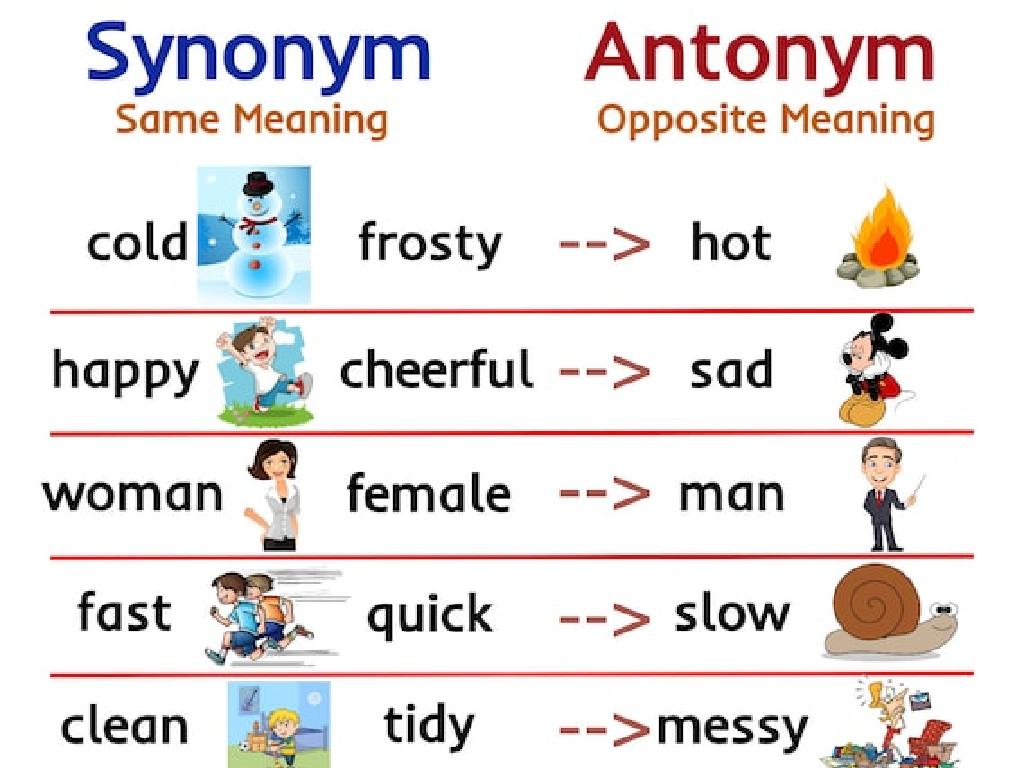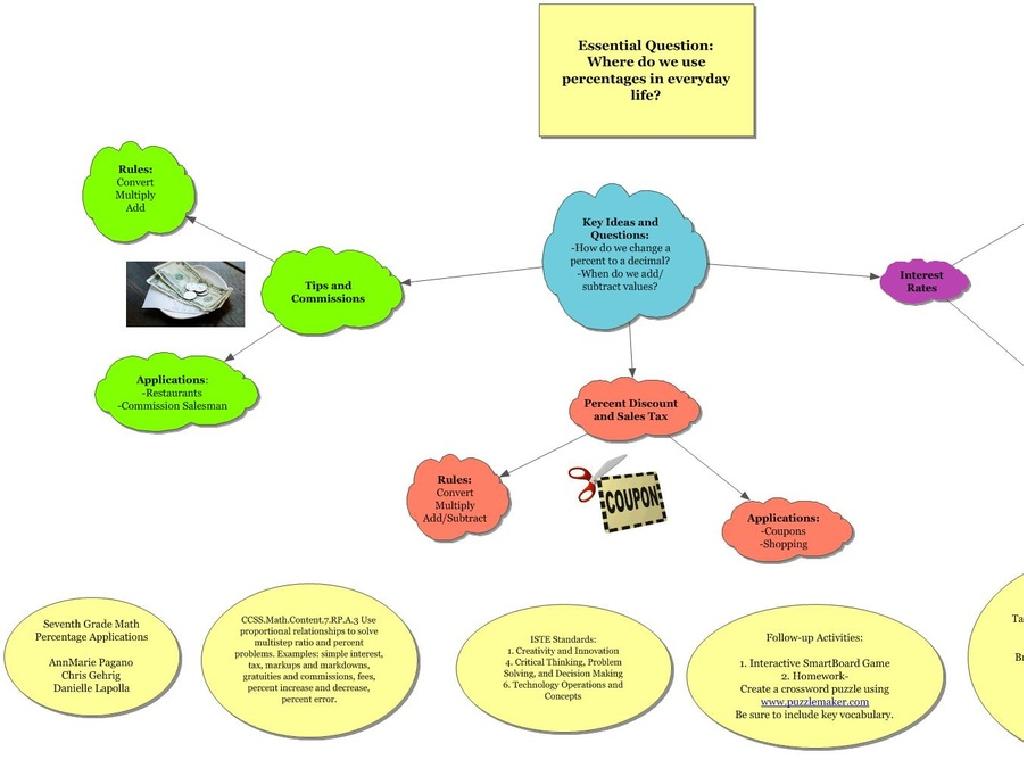Is The Noun Singular Or Plural?
Subject: Language arts
Grade: Third grade
Topic: Nouns
Please LOG IN to download the presentation. Access is available to registered users only.
View More Content
Today’s Adventure: Singular vs. Plural Nouns
– What is a singular noun?
– A singular noun means one item, like ‘dog’ or ‘car’.
– What is a plural noun?
– A plural noun means more than one, like ‘dogs’ or ‘cars’.
– Counting with nouns
– We use nouns to count things: 1 apple, 2 apples.
– Why singular and plural matter
– Knowing the difference helps us talk and write clearly.
|
This slide introduces the concept of singular and plural nouns to third-grade students. Begin by explaining that a singular noun represents just one of something, while a plural noun represents more than one. Use everyday objects in the classroom for clear examples. Emphasize the importance of using the correct noun form to make sure others understand whether we’re talking about a single item or many items. This understanding is crucial for clear communication in both spoken and written language. Encourage students to think of their own examples and to be ready to discuss why it’s important to know the difference between singular and plural nouns.
Exploring Nouns: Singular or Plural?
– What is a noun?
– A noun names a person, place, thing, or idea
– Examples: ‘dog’, ‘school’, ‘happiness’
– ‘dog’ refers to one animal, ‘school’ is one place, ‘happiness’ is one idea
– Nouns as subjects in sentences
– Who or what is the sentence about? That’s the noun!
– Singular vs. Plural nouns
– Singular noun means one, plural means more than one
|
Begin the lesson by defining a noun to the students, ensuring they understand it can be a person, place, thing, or idea. Provide clear examples of nouns that they encounter in their daily lives. Explain that nouns can be the subject of a sentence, which tells us who or what the sentence is about. Introduce the concept of singular and plural nouns, emphasizing that singular nouns mean one, while plural nouns indicate more than one. Use objects in the classroom for tangible examples, and encourage students to come up with their own examples of singular and plural nouns.
Understanding Singular Nouns
– Singular nouns represent ONE
– Use ‘a’ or ‘an’ for singular nouns
– ‘A’ before consonant sounds, ‘an’ before vowel sounds
– Examples: ‘a cat’, ‘an apple’
– ‘A cat’ means one cat, ‘An apple’ means one apple
– Practice identifying singular nouns
|
This slide introduces the concept of singular nouns to third-grade students. Singular nouns refer to one single item or entity. The use of ‘a’ or ‘an’ is a good indicator of a singular noun, with ‘a’ used before words starting with a consonant sound and ‘an’ before words starting with a vowel sound. Provide clear examples like ‘a cat’ or ‘an apple’ to illustrate the concept. Encourage students to practice by identifying singular nouns in sentences and around the classroom. This will help them understand the difference between singular and plural nouns, which is fundamental in sentence construction.
Understanding Plural Nouns
– Plural nouns represent more than one
– Add ‘s’ or ‘es’ to make nouns plural
– If a noun ends in s, x, z, ch, or sh, add ‘es’
– Example: ‘cat’ becomes ‘cats’
– Singular: ‘cat’, Plural: ‘cats’
– Example: ‘apple’ becomes ‘apples’
– Singular: ‘apple’, Plural: ‘apples’
|
This slide introduces the concept of plural nouns to the students, emphasizing that plural nouns are used when there is more than one of something. The general rule for creating plural nouns is by adding ‘s’ or ‘es’ to the end of the word. Provide clear examples like ‘cat’ to ‘cats’ and ‘apple’ to ‘apples’ to illustrate the point. For nouns ending in s, x, z, ch, or sh, ‘es’ is added instead, such as ‘bus’ to ‘buses’ or ‘box’ to ‘boxes’. Encourage students to think of their own examples and write them down. This will help them understand and remember the rule for forming plural nouns.
Special Plural Rules for Nouns
– Some nouns have unique plural forms
– Irregular plurals change differently
– ‘child’ to ‘children’, ‘mouse’ to ‘mice’
– Other examples: ‘man’ to ‘men’, ‘tooth’ to ‘teeth’
– Learn more special plural nouns
– We’ll explore why these changes happen
|
This slide introduces students to the concept of irregular plural nouns, which are nouns that don’t follow the standard rules for becoming plural. Instead of just adding an ‘s’ or ‘es’, these words change in unique ways. Provide students with examples like ‘child’ to ‘children’ and ‘mouse’ to ‘mice’ to illustrate the concept. Encourage students to think of other nouns they know that might have irregular plural forms. In the next class, we will delve deeper into these special nouns, exploring more examples and understanding the historical and linguistic reasons behind these irregularities.
Let’s Practice: Singular or Plural Nouns
– I’ll say a noun; you tell me its number
– Is ‘dogs’ singular or plural?
– ‘Dogs’ sounds like more than one, right?
– What about ‘pencil’?
– Think, does ‘pencil’ mean one or more?
– Now, let’s try ‘leaves’
– ‘Leaves’ is tricky; it ends with ‘ves’!
|
This interactive activity is designed to help students recognize whether a noun is singular or plural. Start by saying the noun ‘dogs’ and ask the students to identify if it’s singular or plural. Encourage them to explain why they think so. Repeat the process with ‘pencil’ and ‘leaves’, guiding them to notice the ‘s’ at the end of ‘dogs’ and ‘ves’ at the end of ‘leaves’ as clues for plural nouns. For ‘pencil’, highlight that it refers to just one and therefore is singular. This exercise will help students understand the concept of number in nouns through practical examples. Be ready to provide additional examples if students grasp the concept quickly.
Class Activity: Noun Hunt
– Let’s go on a noun hunt!
– Find objects in the classroom
– Singular or plural? Decide
– Is it one item (singular) or more (plural)?
– Write down and share findings
– Get ready to tell us about your nouns!
|
This interactive activity is designed to help students identify and categorize nouns based on their quantity. Students will move around the classroom to find various objects, determining whether each object represents a singular noun (one item) or a plural noun (more than one item). Encourage them to write down the nouns they find along with their observations. After the hunt, each student will have the opportunity to share their findings with the class, fostering a collaborative learning environment. For the teacher: Prepare a list of objects that can be easily found in the classroom to guide the students. Consider pairing students to promote teamwork. Have a discussion afterward to correct any misconceptions and reinforce the concept of singular and plural nouns.
Nouns Recap: Singular and Plural
– Congratulations on learning nouns!
– Nouns are everywhere we look
– Everything you see or talk about is a noun
– Practice finding nouns daily
– Keep an eye out for nouns in books, signs, and at home
– Singular vs. Plural review
– Remember, singular means one, plural means more than one
|
This slide is meant to congratulate the students on their hard work learning about singular and plural nouns. It’s a reminder that nouns are all around us – they are people, places, things, and ideas. Encourage the students to practice identifying nouns in their environment, whether they’re at home, outside, or reading. Reinforce the concept that singular nouns mean just one, while plural nouns indicate more than one. You can suggest that they make a game out of finding and categorizing nouns to reinforce their learning in a fun way.






